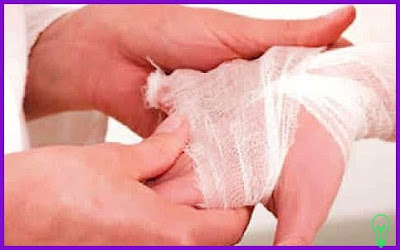Burns demolish skin, which can guide to us losing heat as well as losing significant bodily fluids.

Plus, burns can make us susceptible to infection. While minor burns on fingers and hands are not terribly dangerous, burns on even relatively small areas of skin are capable of developing serious complications. If you think a burn of any type is significant, stop reading this and call 911 immediately.
For a video demonstration of burn treatments, watch How to Treat a Burn. To understand how deep burns look and what they do to skin.
1. Stop the burning process. Cool the burned area with cool running water for several minutes. Minor burns can be cooled with tap water over the sink. Don't be afraid to rinse bigger burns with a hose outside. Don't spray severe burns with high pressure, just let the water run over the burned area for as long as you can.
If an ambulance is coming, continue running water over the burned area until the ambulance arrives.
2. Look for blistering, sloughing, or charred (blackened) skin.
Blistering or sloughing (skin coming off) means the top layer of skin is completely damaged and infections are likely. Here is a picture of burned skin coming off.
If the blistered or charred skin is all the way around a wrist, arm, leg or ankle; if it covers most of a foot or hand; or if the blisters cover an area the size of the belly, call 911 immediately. Also call 911 if the burn is around the mouth, nose or eyes, or if the burn is on the genitalia.
3. Minor burns with reddened skin and no blisters may be treated with a topical burn ointment or spray to reduce pain. Ointments should be water soluble.
Cool water (not ice cold or warm) may also help with pain.
DO NOT APPLY BUTTER OR OIL TO ANY BURN! Butter or lard may feel cool because it comes out of the refrigerator, but the oils will trap heat and make the burn deeper over time.
4. Over the counter pain relievers like ibuprofen or acetaminophen can be used for the pain of a mild burn (typically redness only). If stronger pain relief is needed, call a doctor or go to the emergency department.
Tips:
1. While the burn is healing, wear loose natural clothing like silks or light cottons. Harsher fabrics will irritate the skin even more.
2. Burns destroy skin and the loss of skin can lead to infection, dehydration and hypothermia (loss of body heat). Make sure that burn victims get emergency medical help if experiencing any of the following:
* dizziness or confusion
* weakness
* fever or chills
* shivering
* cold sweats
Thanks:firstaid.about.com

Plus, burns can make us susceptible to infection. While minor burns on fingers and hands are not terribly dangerous, burns on even relatively small areas of skin are capable of developing serious complications. If you think a burn of any type is significant, stop reading this and call 911 immediately.
For a video demonstration of burn treatments, watch How to Treat a Burn. To understand how deep burns look and what they do to skin.
1. Stop the burning process. Cool the burned area with cool running water for several minutes. Minor burns can be cooled with tap water over the sink. Don't be afraid to rinse bigger burns with a hose outside. Don't spray severe burns with high pressure, just let the water run over the burned area for as long as you can.
If an ambulance is coming, continue running water over the burned area until the ambulance arrives.
2. Look for blistering, sloughing, or charred (blackened) skin.
Blistering or sloughing (skin coming off) means the top layer of skin is completely damaged and infections are likely. Here is a picture of burned skin coming off.
If the blistered or charred skin is all the way around a wrist, arm, leg or ankle; if it covers most of a foot or hand; or if the blisters cover an area the size of the belly, call 911 immediately. Also call 911 if the burn is around the mouth, nose or eyes, or if the burn is on the genitalia.
3. Minor burns with reddened skin and no blisters may be treated with a topical burn ointment or spray to reduce pain. Ointments should be water soluble.
Cool water (not ice cold or warm) may also help with pain.
DO NOT APPLY BUTTER OR OIL TO ANY BURN! Butter or lard may feel cool because it comes out of the refrigerator, but the oils will trap heat and make the burn deeper over time.
4. Over the counter pain relievers like ibuprofen or acetaminophen can be used for the pain of a mild burn (typically redness only). If stronger pain relief is needed, call a doctor or go to the emergency department.
Tips:
1. While the burn is healing, wear loose natural clothing like silks or light cottons. Harsher fabrics will irritate the skin even more.
2. Burns destroy skin and the loss of skin can lead to infection, dehydration and hypothermia (loss of body heat). Make sure that burn victims get emergency medical help if experiencing any of the following:
* dizziness or confusion
* weakness
* fever or chills
* shivering
* cold sweats
Thanks:firstaid.about.com



